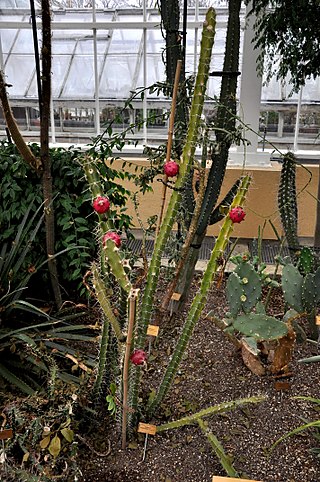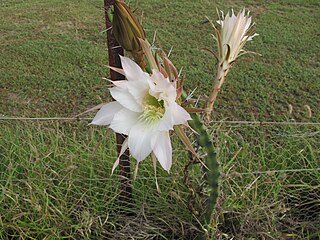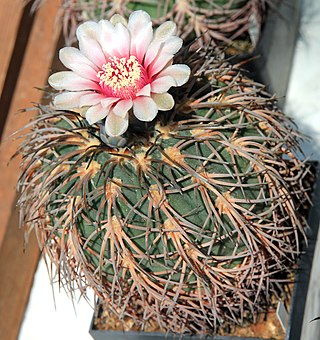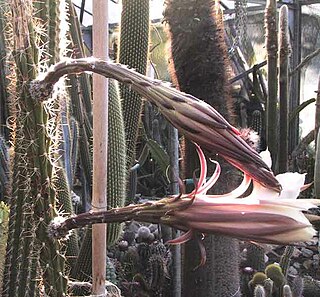
Harrisia is a genus of night blooming cacti.

Harrisia aboriginum, the west-coast prickly apple or prickly applecactus, is a species of columnar cactus endemic to peninsular Florida, on the Gulf Coast of the counties of Lee, Sarasota County, and Charlotte. Only 12 occurrences are known, and the species is threatened by horticultural collection, shading from fire suppression, competition from invasive flora, and most of all habitat destruction. It is a federally listed endangered species of the United States.

Harrisia bonplandii is a species of cactus. The cactus plants in the Gran Chaco are generally called tuna and this specific variety reina de la noche. Fruits and roots are edible and well known to the native nations of the Gran Chaco.

Harrisia martinii, commonly called the Martin applecactus, is a species of night-blooming, rope-like cacti native to South America. With large showy flowers that attract the hawk moth, it is considered by some a useful landscape plant in areas that do not freeze.

Harrisia pomanensis is a species of cactus.

Harrisia portoricensis is a species of cactus in the genus Harrisia. Its common names include higo chumbo and Puerto Rico applecactus.

Pachycereus pecten-aboriginum is a columnar cactus plant native to Mexico. They can grow up to 15 m (49 ft) high. The trunk of this species is 1.2 to 5.0 m tall and the fruits are large and burr-like. The specific name, pecten-aboriginum, is from the Latin, and means "native combs". It was inspired by the use of the fruits as hair combs.

Parodia ottonis, also known as Indian head cactus, is a cactus found in Argentina, Brazil, Paraguay and Uruguay. There are two recognized subspecies. The epithet ottonis honors the German botanist Christoph Friedrich Otto.

Harrisia tortuosa is a species of cactus in the Trichocereeae tribe.

Gymnocalycium spegazzinii is a species of Gymnocalycium from Argentina and Bolivia named after the botanist C. L. Spegazzini.

Armatocereus cartwrightianus is a species of Armatocereus from Ecuador and Peru.

Cereus hexagonus or lady of the night cactus is a species of columnar cactus found in Ecuador and Venezuela.

Lobivia pentlandii, is a species of Lobivia found in Bolivia and Peru.

Harrisia brookii is a species of cactus found in the Bahamas.

Pelecyphora cubensis is a species of flowering plant in the family Cactaceae, native to Cuba.
Weberbauerocereus churinensis is a species of cactus in the genus Weberbauerocereus, native to Peru.
Harrisia adscendens is a species of cactus found in Brazil.

Harrisia eriophora is a species of cactus found in Cuba.
Harrisia fernowii is a species of cactus found in Cuba.

Harrisia taetra is a species of cactus found in Cuba.


















